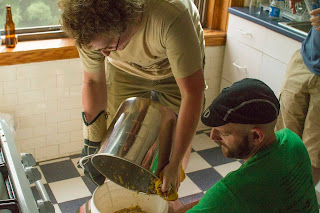However, I went out with quite the bang! I wanted to try a number of batches before I took off. Hence, I hosted a 'Homebrew Bash' at my place, a day in which all those interested could come and brew or learn about brewing in addition to helping me consume the excess of beer I'd been hoarding.
It was a great success! We made four beers: old style Dusseldorf altbier, Real Raspberry, Bitter Than You, and a tomato basil beer.
Old World Alt
The old world alt was an attempt to recreate my experience from Dusseldorf the previous summer. I'd tried many American takes on the altbier, but was always disappointed. Something about them seemed to be to strong and scream American microbrew. You can learn more about altbier and the recipe variation that I based mine off of at http://byo.com/stories/item/1205-old-world-alt.
I ended up actually kegging this as a surprise for my friend's birthday party. It turned out quite well, although I didn't hit the taste and lightness I'd hope for. I think my failure was in substituting too much Munich malt. However, it was still a great success and people at the party loved it.
Tomato Basil
This was the concept of my guest brewer, Ed, who'd tried something along similar lines in Japan but did not have the recipe or even name of the Japanese microbrew. However, he came up with a recipe. The process ended up being extremely messy it required a lot of tomato blending, sparging, and then using the basil as a sort of hops. However, all of it was worth it when I tried a bottle... absolutely amazing.
It was the sort of stuff that could easily end up as a flagship beer for a microbrew. Extremely refreshing, filled with flavor, had exactly the right amount of sweetness (I think that was the tomato), and a perfect aftertaste (basil). Either way, I eagerly await future variations on it. Well done Ed!
 |
| Tomatoes! |
 |
| And sparging! |
 |
| Hops and basil! |
Bitter Than You
I'm always disenchanted by various microbreweries' IPAs. It seems that there are so many unremarkable ones out there (although there are certainly a few amazing ones). My theory it's quite easy to make a mediocre IPA, so I decided to put this to the test with a rather unplanned recipe. I bought four different types of hops high on the alpha acid scale and used some pretty straightforward malt combo and boiled for 60 minutes. I hit a total of 240 IBU (note: the max you can taste is 100). I haven't tried any of it beyond two weeks of bottling yet, but it tasted just as I'd expected. Bitter enough to drown out virtually all other flavors. Good though!
Real Raspberry
When organizing the event, I'd asked if there were any recipe suggestions. One of the attendees insisted on a raspberry beer. Now I'd done a peach wheat before with peach extract which turned out well. You'd be surprised at the number of commercial beers that use extracts actually. However, I decided I wanted to try something new and use real fruit this time. About 3 lbs of real raspberries.
The base beer was a simple wheat. The biggest decision I faced was whether to add the raspberries during the boil, or after most of the primary fermentation had taken place. After researching a bit I went with the latter and once the primary looked liked it had stopped bubbling I sanitized the raspberries and threw them in there to reignite the yeast!
 |
| Boiling raspberries! |
While I didn't get a chance to try a fully ready version, what I tried tasted just as I'd hoped. It definitely had a nice raspberry flavor that was light enough not to overwhelm. However, I hope to soon hear reviews from friends to whom I've distributed the bottles.
In the end, the homebrew bash was a great way to leave town... and I can't wait to try some more of Bitter Than You and Real Raspberry when I make my way back to Boston. In the meantime, I've even left some fun experiments fermenting.









